How to transplant ficus?
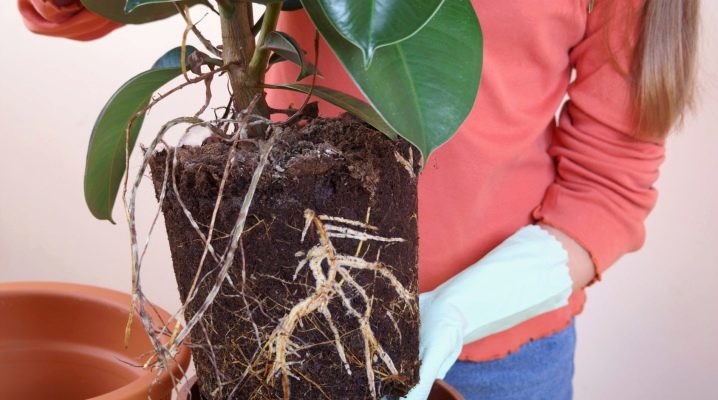
Ficuses are graceful indoor plants that are popular with flower growers due to their amazing decorative effect. So that these unpretentious creatures can fully grow and develop, delighting their owner with emerald glossy foliage, it is important for them to provide comfortable living conditions. One of the important nuances of growing ficuses is associated with their transplants. Consider how a plant is transplanted, and what conditions must be observed during this procedure.

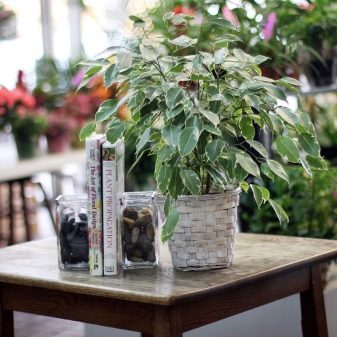
Causes
Plant transplant is a responsible and time-consuming procedure that requires compliance with a number of important requirements. First of all, you should make sure that the ficus really needs to change the pot and substrate. The fact that the time has come to transplant the ficus is indicated by such signs as:
- germination of roots through holes for water drainage;
- quick drying of the clod of earth after watering;
- young leaves are much smaller in size than old ones;
- waterlogging the soil in a pot.
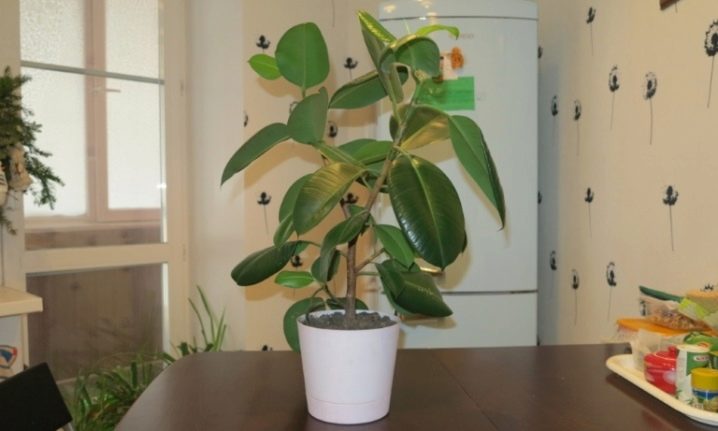
Germination of roots
The fact that the roots of the ficus became cramped in the pot is evidenced by their active germination outside the container. In search of free space, the roots begin to penetrate through drainage holes, where they can be seen with the naked eye. Roots often intertwined with each other crawl out to the surface of the earth, trying to break out of the edges of the pot.

Rapid drying of the earth
One of the sure signs that the plant needs an urgent transplant is the rapid drying of the earthen coma after watering. When the volume of the root mass exceeds the volume of the earthen coma, moisture is not retained in the substrate, but is actively absorbed by the roots. This leads to a significant increase in the frequency of watering.
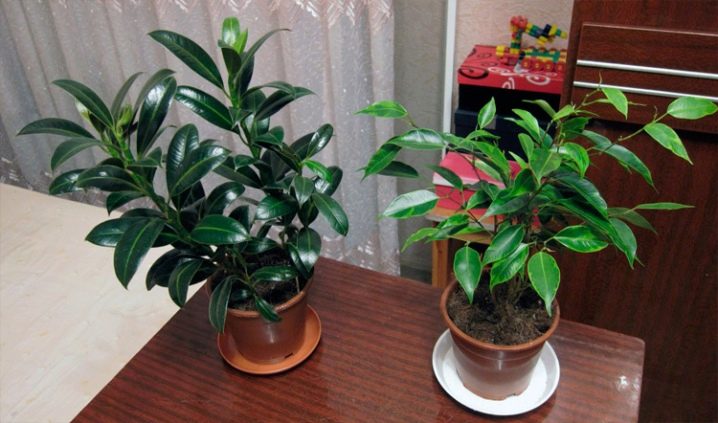
Difference in leaf size
If the young leaves of the ficus tree cannot match the size of the old foliage in any way, this clearly indicates that the plant lacks the appropriate resources - moisture and nutrients. A shortage of these resources occurs when the pot becomes too small for the ficus, and the intertwined roots begin to cope poorly with their functions.
This, in turn, requires an emergency transplant.
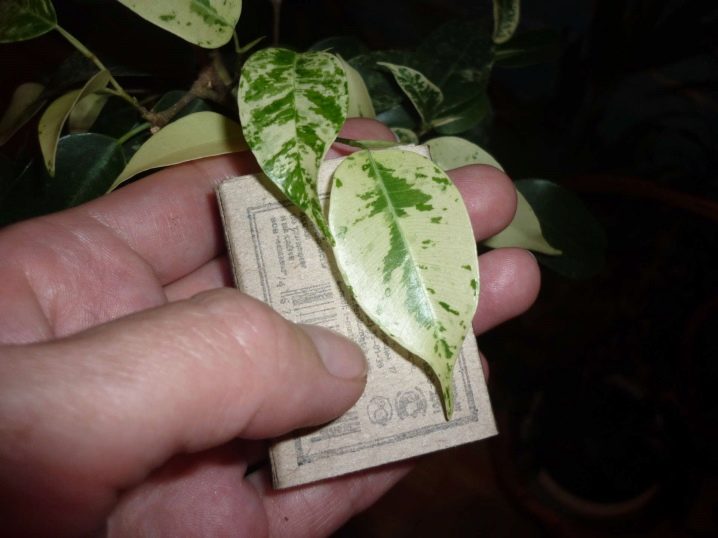
Waterlogging of the substrate
The consequence of an increase in the frequency of watering is acidification and waterlogging of the soil substrate in a pot with a plant. As a result, the earthen lump begins to exude an unpleasant odor, and a specific plaque forms on the surface of the soil. This greatly increases the risk of developing root rot, which can destroy the plant.
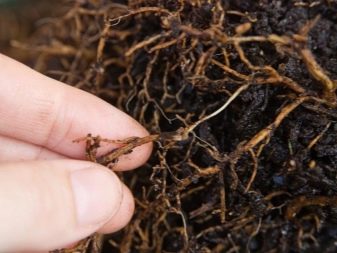

Other
Ficuses recently purchased in the store are to be transplanted. After purchase, they are kept in quarantine for 2-3 weeks, isolated from other plants, and then prepared for transplantation. The need for this procedure is due to the fact that usually a store-bought substrate is not suitable for the further cultivation of ficuses. This soil mixture is used to facilitate the transport of plants. It is denser, poorly drained, and poor in nutrients. It is highly undesirable to use store-bought soil mixture for growing indoor plants.
When calculating the timing of transplanting plants, it is necessary to take into account their age.
For example, young ficuses less than three years old should be replanted every year.At this age, plants are actively developing, increasing the green and root mass, and therefore they need to regularly replace old cramped pots with more spacious containers.
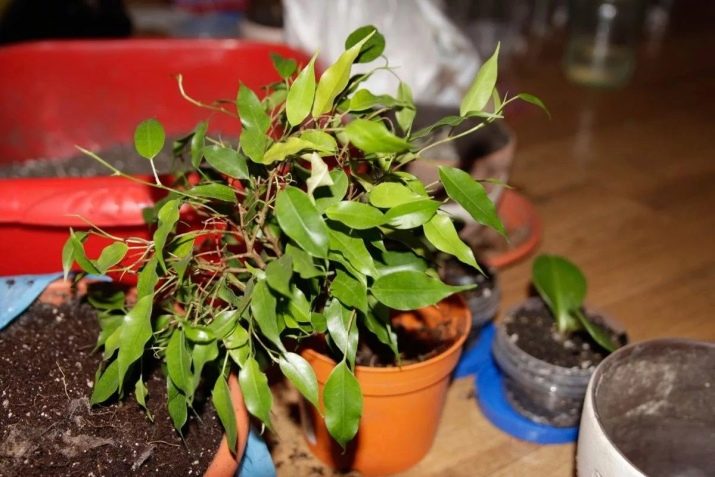
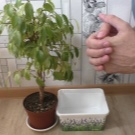
Older trees, whose age ranges from 3 to 6 years, are transplanted once every two years. Plants at this interval of life slightly slow down their rates of development, although they continue to form new shoots and roots. By replanting a plant of this age according to the schedule, the grower provides his green pet with optimal and comfortable living conditions.
Mature ficuses at the age of 6 years or more are transplanted every 5 years. Periodically, to renew the depleted soil from the pot, carefully remove the top layer and cover with fresh nutrient soil.

When can you do this?
When planning to transplant ficus, it is necessary to take into account the time of the year in which it is best and safest to carry out this procedure. Experienced growers recommend replanting plants in early spring - until the moment when they enter the awakening phase, starting to actively grow and develop.
In some cases, it is allowed to carry out a transplant in the fall, when the plant is preparing for the upcoming winter season. While the weather is warm and sunny, the transplanted ficus will have time to recover. It is undesirable to transplant in November and in the following winter months, since at this stage the plant's vital processes slow down.
It is possible to transplant ficuses in winter only in the most extreme cases, caused, for example, by an attack of insect pests or the development of diseases that require urgent treatment.
Most ficuses are painfully tolerant of transplantation, which takes a lot of their strength for adaptation and recovery. To a greater extent, this applies to transplants made in winter. Therefore, when replanting plants in December, January or February, you should be prepared for the fact that the ficus can shed all the leaves, acquire a painful and unpresentable look.
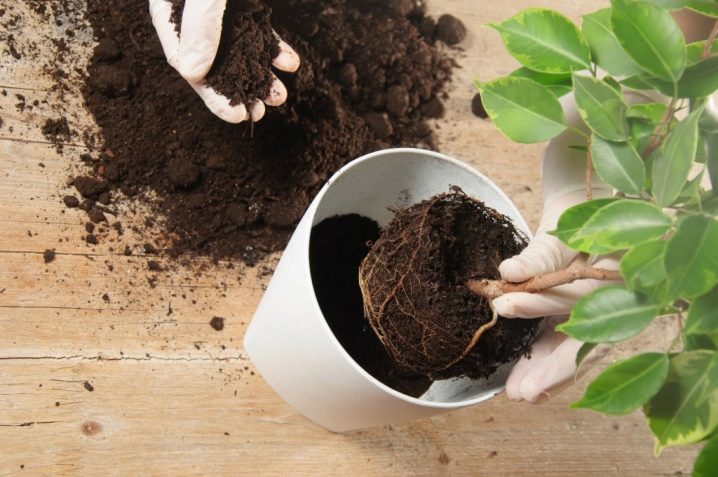
Preparation
When starting to transplant ficus, you should prepare a new capacious container and fresh substrate in advance. The plant pot can be either plastic or ceramic. Speaking about the size of the container, flower growers recommend giving preference to pots in which the height and width are approximately the same. It is important to ensure that there are drainage holes at the bottom of the container to drain water.
In advance, new pots are disinfected using boiling water, a solution of potassium permanganate or an alcohol-containing agent. It is preferable that the new container is about 3 centimeters larger in width and height than the old pot.

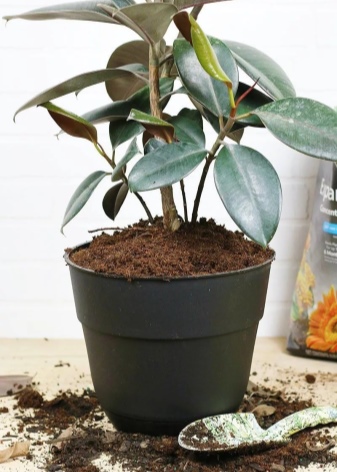
The soil for the ficus should be light, moisture and breathable.
Slightly acidic or neutral soil is most preferred. Dense soils containing a large amount of clay are absolutely not suitable for ficuses.
Depending on the age of the plant, the composition of the soil may be different. So, for young ficuses, a soil mixture of peat, deciduous humus and sand, taken in equal proportions, is recommended. For older plants, a mixture of turf, sand and peat is suitable (all ingredients are taken in equal proportions).

When preparing the soil mixture, it is allowed to add a small amount of drainage into it - crushed expanded clay, fine gravel, river pebbles. A two- or three-centimeter drainage layer is also laid on the bottom of the pot. For greater air permeability, vermiculite is added to the soil mixture.
Before planting, the soil mixture is spilled with a solution of potassium permanganate, which will destroy the likely pathogens. And also the substrate should be treated with the drug "Fitosporin", which will provide prophylaxis against fungal diseases and parasites.
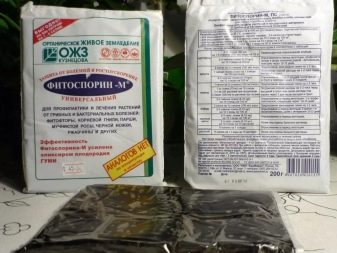

How to transplant?
A couple of days before the transplant, the ficus is not watered.This will allow the earthen coma to dry out a little and become lighter, which will reduce the load on the roots and make it easier to transplant at home.
It should not be forgotten that new plants after purchase in the store are transplanted only after 2-3 weeks. During this period of time, the ficus will have time to adapt to unusual conditions, and the grower will have the opportunity to objectively assess his condition.
When preparing for a ficus transplant, you should arm yourself with the following auxiliary tools and materials:
- old newspapers;
- small spatula for flowers;
- sharp scissors (for trimming damaged roots and shoots);
- watering can with warm, settled water.

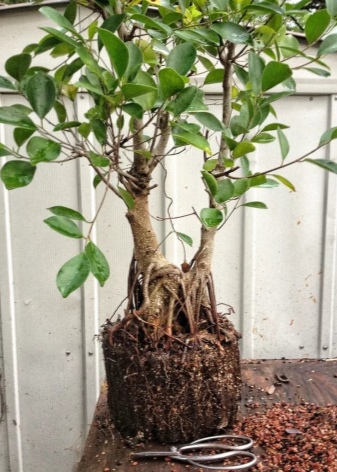
For the convenience of the procedure, the working area is covered with newspapers. An empty basin is placed next to it for pouring excess substrate or old earth, tools are laid out - scissors, a spatula or scoop, a watering can.
A new pot is prepared immediately before the procedure. A layer of prepared and treated substrate is poured into it on top of the drainage layer, filling about a third of the container. Then, holding the ficus by the root collar, carefully remove it from the old pot along with a lump of earth. If the plant is difficult to remove, you can gently tap on the outside of the pot. In very difficult cases, if the ficus is too large and powerful, it is allowed to use a wooden stick, with which the adhered roots are carefully detached from the walls of the container.
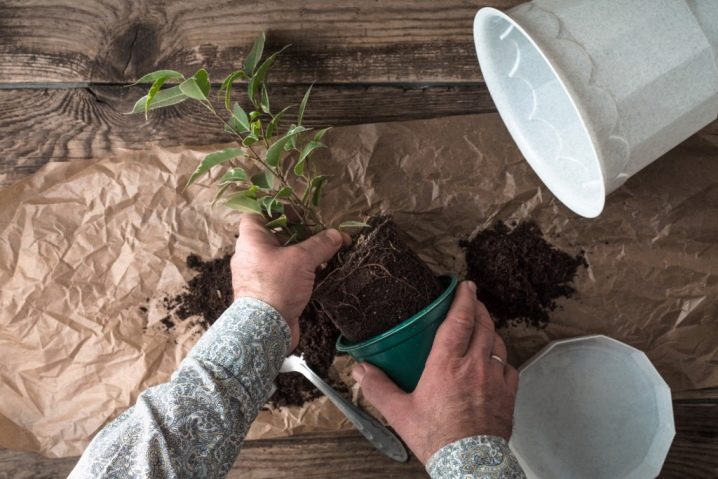
Following all the recommendations for transplanting step by step, you should examine the roots of the flower after extraction. In a healthy plant, the roots are white, light yellow or beige. When a plant is damaged by pests or pathogens, the roots acquire a reddish brown, dirty gray, dark brown hue.
Found dry, diseased, damaged and rotten roots should be carefully trimmed to a healthy part, after which the cut site should be powdered with ash or crushed charcoal.
If there are traces of pest damage on the root system, the plant is subject to careful treatment with chemicals - insecticides.
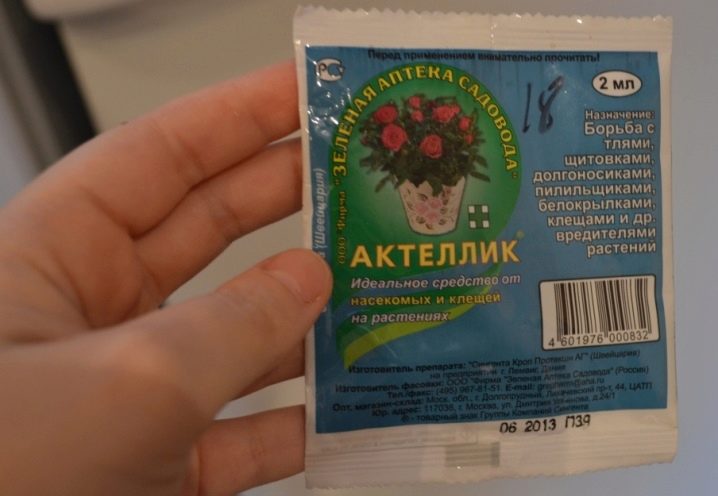
After inspection and processing, the ficus, together with a lump of earth on the roots, is placed in another pot. Among flower growers, this method is called "transshipment". In order to correctly and with the least damage to transplant ficus using this method, you need to focus on the center of the pot. The trunk of the tree should be located in the center of the container.
Next, the pot is completely filled with a loose substrate and carefully tamped on top with a spatula. At the end of the work, the flower is carefully watered with a solution of a root-forming stimulant. When the earthen lump dries up a little, the plant is watered again, but with ordinary settled water. The next watering is recommended only after a week, when the tree takes root a little and regains its strength.
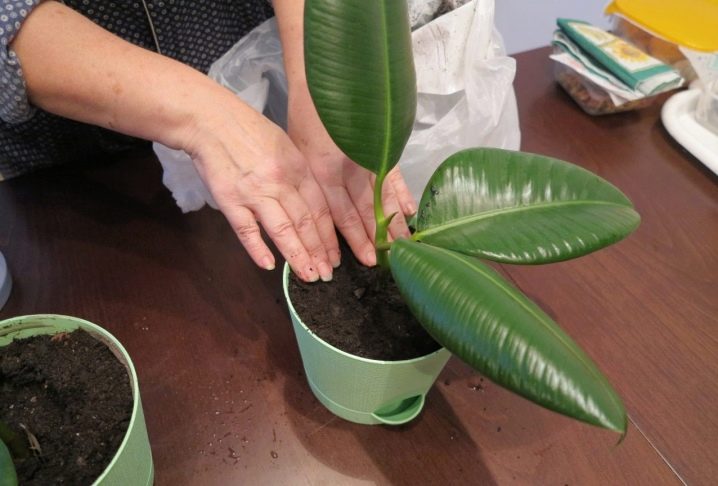
Follow-up care
The transplant will not be very stressful and painful for the plant if the grower follows all the recommendations prescribed in the instructions. A very important stage after transplantation is recovery, during which the flower should be looked after with particular care.
Care during the recovery period of the ficus after transplantation provides for the creation of the most gentle conditions for it. These include such as:
- fairly plentiful, but soft lighting;
- stable air temperature;
- constant humidity of air and substrate.
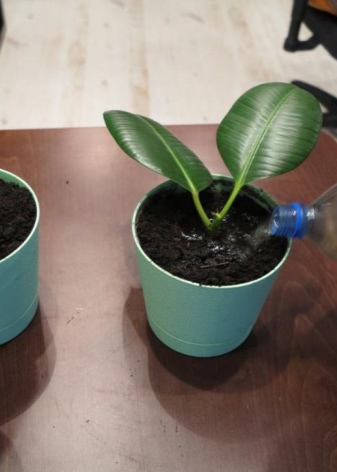
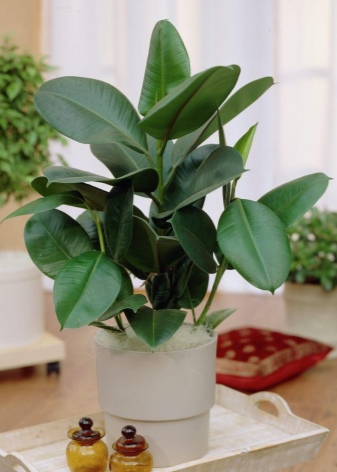
While the plant is adapting after transplanting, it needs to provide an abundance of soft, diffused light. It is not allowed to expose ficus on the windowsill so that direct sunlight falls on it.
Post-transplant recovery will be faster and more comfortable if the room temperature is kept constant at 22-23 degrees Celsius.Drafts, cold and temperature changes are detrimental to the described evergreens, so these factors should be carefully avoided.

Dry air is harmful to ficuses, so it is recommended to spray the plants regularly in hot weather. Some growers from time to time spray ficuses with water with the addition of Epin. It allows you to restore the strength of the plant after suffering stress, stimulating its intensive development.
If, after transplanting, the ficus has dropped the leaves or even dropped the foliage altogether, you do not need to panic. In most cases, this is a natural response to stress. The risk of wilting and falling foliage increases many times over if the transplant was made at the wrong time - in particular, in winter.
It is recommended to hide transplanted small-sized ficuses under a film by arranging an impromptu greenhouse over the pot. In such conditions, plants will recover faster from the stress they have endured.
How to transplant ficus from a store, see the video below































The comment was sent successfully.